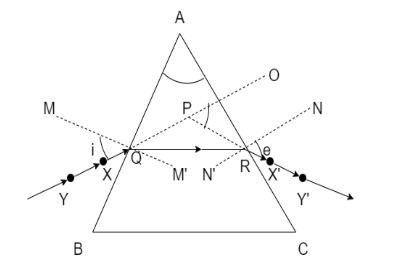
a) Draw a ray diagram of refraction of light through a prism and explain the phenomenon of dispersion of light.
b) Write the formula for lens power and define its unit.
Answer
560.7k+ views
Hint:Recall that when a ray of light travels from one medium to another, then it changes the direction. This phenomenon is known as refraction of light. While the separation of white light into its component colors is known as dispersion of light.
Complete step by step answer:
Step I:
Below is the ray diagram of refraction of light through a glass prism. Since light rays travel from air to glass and glass is denser than air, so the light ray will undergo refraction and change its direction.

Step II:
When white light is made to pass through a glass prism, then it splits into its constituent colors that are usually known as VIBGYOR. These colors include violet, indigo, blue, green, yellow, orange and red.
Step III:
Power of a lens is defined as the inverse or reciprocal of the focal length of the lens. It basically shows the amount of deviation that a lens produces. It is usually measured in meters and denoted by using the symbol ‘P’. Mathematically it can be written as
$P = \dfrac{1}{f}$
Power of a convex lens is positive and a concave lens is negative. A plane glass plate has zero power.
Note:It is important to remember that the white light undergoes refraction twice when it passes through prism. This is because it passes from air to glass where it slows down and then passes from glass to air where it speeds up. Since different colors of light have different wavelengths, the speed with which they bend will also be different. The violet color has the shortest wavelength and bends the most while the red color has the longest wavelength and bends the least.
Complete step by step answer:
Step I:
Below is the ray diagram of refraction of light through a glass prism. Since light rays travel from air to glass and glass is denser than air, so the light ray will undergo refraction and change its direction.

Step II:
When white light is made to pass through a glass prism, then it splits into its constituent colors that are usually known as VIBGYOR. These colors include violet, indigo, blue, green, yellow, orange and red.
Step III:
Power of a lens is defined as the inverse or reciprocal of the focal length of the lens. It basically shows the amount of deviation that a lens produces. It is usually measured in meters and denoted by using the symbol ‘P’. Mathematically it can be written as
$P = \dfrac{1}{f}$
Power of a convex lens is positive and a concave lens is negative. A plane glass plate has zero power.
Note:It is important to remember that the white light undergoes refraction twice when it passes through prism. This is because it passes from air to glass where it slows down and then passes from glass to air where it speeds up. Since different colors of light have different wavelengths, the speed with which they bend will also be different. The violet color has the shortest wavelength and bends the most while the red color has the longest wavelength and bends the least.
Recently Updated Pages
Master Class 12 English: Engaging Questions & Answers for Success

Master Class 12 Business Studies: Engaging Questions & Answers for Success

Master Class 12 Economics: Engaging Questions & Answers for Success

Master Class 12 Social Science: Engaging Questions & Answers for Success

Master Class 12 Maths: Engaging Questions & Answers for Success

Master Class 12 Chemistry: Engaging Questions & Answers for Success

Trending doubts
What are the major means of transport Explain each class 12 social science CBSE

Which are the Top 10 Largest Countries of the World?

Draw a labelled sketch of the human eye class 12 physics CBSE

Explain sex determination in humans with line diag class 12 biology CBSE

The pH of the pancreatic juice is A 64 B 86 C 120 D class 12 biology CBSE

Explain sex determination in humans with the help of class 12 biology CBSE




